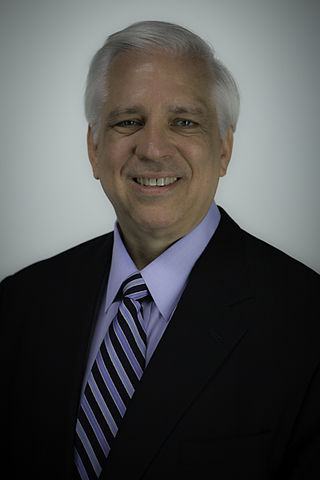
The Centers for Medicare & Medicaid Services (CMS) is a federal agency within the United States Department of Health and Human Services (HHS) that administers the Medicare program and works in partnership with state governments to administer Medicaid, the Children's Health Insurance Program (CHIP), and health insurance portability standards. In addition to these programs, CMS has other responsibilities, including the administrative simplification standards from the Health Insurance Portability and Accountability Act of 1996 (HIPAA), quality standards in long-term care facilities through its survey and certification process, clinical laboratory quality standards under the Clinical Laboratory Improvement Amendments, and oversight of HealthCare.gov. CMS was previously known as the Health Care Financing Administration (HCFA) until 2001.
Health Level Seven, abbreviated to HL7, is a range of global standards for the transfer of clinical and administrative health data between applications with the aim to improve patient outcomes and health system performance. The HL7 standards focus on the application layer, which is "layer 7" in the Open Systems Interconnection model. The standards are produced by Health Level Seven International, an international standards organization, and are adopted by other standards issuing bodies such as American National Standards Institute and International Organization for Standardization. There are a range of primary standards that are commonly used across the industry, as well as secondary standards which are less frequently adopted.
Health technology is defined by the World Health Organization as the "application of organized knowledge and skills in the form of devices, medicines, vaccines, procedures, and systems developed to solve a health problem and improve quality of lives". This includes pharmaceuticals, devices, procedures, and organizational systems used in the healthcare industry, as well as computer-supported information systems. In the United States, these technologies involve standardized physical objects, as well as traditional and designed social means and methods to treat or care for patients.

Continua Health Alliance is an international non-profit, open industry group of nearly 240 healthcare providers, communications, medical, and fitness device companies. Continua was a founding member of Personal Connected Health Alliance which was launched in February 2014 with other founding members mHealth SUMMIT and HIMSS.
Medical equipment management is a term for the professionals who manage operations, analyze and improve utilization and safety, and support servicing healthcare technology. These healthcare technology managers are, much like other healthcare professionals referred to by various specialty or organizational hierarchy names.
Health information technology (HIT) is health technology, particularly information technology, applied to health and health care. It supports health information management across computerized systems and the secure exchange of health information between consumers, providers, payers, and quality monitors. Based on a 2008 report on a small series of studies conducted at four sites that provide ambulatory care – three U.S. medical centers and one in the Netherlands, the use of electronic health records (EHRs) was viewed as the most promising tool for improving the overall quality, safety and efficiency of the health delivery system.
The Office of the National Coordinator for Health Information Technology (ONC) is a staff division of the Office of the Secretary, within the U.S. Department of Health and Human Services. ONC leads national health IT efforts. It is charged as the principal federal entity to coordinate nationwide efforts to implement the use of advanced health information technology and the electronic exchange of health information.
West Health is a group of non-profit organizations in the United States that is working to lower healthcare costs so that seniors can successfully age in place.

Stephen L. Ondra is the chief medical adviser for the MITRE Corporation’s work as operator of the CMS Alliance to Modernize Healthcare federally funded research and development center. Ondra advises all HHS organizations to advance private insurance markets, Medicare and Medicaid, value-based payments, and healthcare quality. Ondra was most recently CEO of Cygnus-AI Inc., a company specializing in artificial intelligence and clinical decision support tools for diagnostic radiology. He was also founder and chief executive officer of North Star Health Care Consulting, and served on the board of directors of Triple-S Management and electroCore. A neurosurgeon and neuroscientist, Ondra has also served in senior positions in the Federal government, having a role in health reform efforts and the implementation of the Affordable Care Act. He advises corporations, provider organizations and early-stage start-ups on the transition to value-based care and health IT strategy.

Dan Riskin is an American entrepreneur and surgeon. As an expert in healthcare artificial intelligence, Riskin has promoted healthcare quality improvement and helped shape policy in the US and globally. Riskin's companies, featured in Forbes and The Wall Street Journal, have influenced the care of millions of patients. He continues to practice, teach, and perform research as Clinical Professor of Surgery at Stanford University.
The Fast Healthcare Interoperability Resources standard is a set of rules and specifications for exchanging electronic health care data. It is designed to be flexible and adaptable, so that it can be used in a wide range of settings and with different health care information systems. The goal of FHIR is to enable the seamless and secure exchange of health care information, so that patients can receive the best possible care. The standard describes data formats and elements and an application programming interface (API) for exchanging electronic health records (EHR). The standard was created by the Health Level Seven International (HL7) health-care standards organization.
Digital health is a discipline that includes digital care programs, technologies with health, healthcare, living, and society to enhance the efficiency of healthcare delivery and to make medicine more personalized and precise. It uses information and communication technologies to facilitate understanding of health problems and challenges faced by people receiving medical treatment and social prescribing in more personalised and precise ways. The definitions of digital health and its remits overlap in many ways with those of health and medical informatics.
Medical device connectivity is the establishment and maintenance of a connection through which data is transferred between a medical device, such as a patient monitor, and an information system. The term is used interchangeably with biomedical device connectivity or biomedical device integration. By eliminating the need for manual data entry, potential benefits include faster and more frequent data updates, diminished human error, and improved workflow efficiency.

Integrating the Healthcare Enterprise (IHE) is a non-profit organization based in the US state of Illinois. It sponsors an initiative by the healthcare industry to improve the way computer systems share information. IHE was established in 1998 by a consortium of radiologists and information technology (IT) experts.
Health Level Seven International (HL7) is a non-profit ANSI-accredited standards development organization that develops standards that provide for global health data interoperability.

David Bates is an American physician, biomedical informatician, and professor, known for his work regarding the use of health information technology (HIT) to improve the safety and quality of healthcare, in particular by using clinical decision support. Bates has done work in the area of medication safety. He began by describing the epidemiology of harm caused by medications, first in hospitalized patients and then in other settings such as the home and nursing homes.
Health care analytics is the health care analysis activities that can be undertaken as a result of data collected from four areas within healthcare: (1) claims and cost data, (2) pharmaceutical and research and development (R&D) data, (3) clinical data, and (4) patient behaviors and preferences data. Health care analytics is a growing industry in many countries including the United States, where it is expected to grow to more than $31 billion by 2022. It is also increasingly important to governments and public health agencies to support health policy and meet public expectations for transparency, as accelerated by the Covid-19 pandemic.

The Canadian Medical and Biological Engineering Society (CMBES) is a technical society representing the biomedical engineering community in Canada. CMBES is supported by its membership which consists of biomedical engineers, biomedical engineering technologists and students. CMBES also hosts an annual conference and regular webinars. It produces a number of publications including the Clinical Engineering Standards of Practice and a Newsletter. The Society's aims are twofold: scientific and educational: directed toward the advancement of the theory and practice of medical device technology; and professional: directed toward the advancement of all individuals in Canada who are engaged in interdisciplinary work involving engineering, the life sciences and medicine.
Lisa Bari is an American health policy strategist and consultant. For a period, she served as the lead of health information technology and interoperability at the federal Centers for Medicare and Medicaid Services Innovation Center (CMS).
Insup Lee is the Cecilia Fitler Moore Professor in the Department of Computer and Information Science at the University of Pennsylvania, United States. He is also the Director and co-founder of the PRECISE Center.





